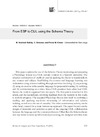Please use this identifier to cite or link to this item:
https://accedacris.ulpgc.es/jspui/handle/10553/12240
| DC Field | Value | Language |
|---|---|---|
| dc.contributor.author | Nashaat Sobhy, Nashwa | en_US |
| dc.contributor.author | Berzosa, César | en_US |
| dc.contributor.author | Crean, Fiona M. | en_US |
| dc.date.accessioned | 2014-10-01T02:30:30Z | - |
| dc.date.accessioned | 2018-03-15T14:28:01Z | - |
| dc.date.available | 2014-10-01T02:30:30Z | - |
| dc.date.available | 2018-03-15T14:28:01Z | - |
| dc.date.issued | 2013 | en_US |
| dc.identifier.issn | 1133-1127 | en_US |
| dc.identifier.uri | https://accedacris.ulpgc.es/handle/10553/12240 | - |
| dc.description.abstract | This paper explains the use of the Schema Theory in planning and preparinga Physiology lesson in a CLIL tertiary context in a Spanish university. Theadopted combination of methods used in applying the theory is transferable toany context and subject. Scaffolding for content and language learning wasundertaken using schema-building through activities involving: (1) sequencing;(2) using an exercise with causality language for purposeful reading (3) outlining;and (4) commentating on a video. Since CLIL practices have often lead CLILtheory, the study is organized into two parts. The first part is described in thisarticle, and the second part, involving feedback from the students in this study,is work in progress. The required Physiology lesson lent itself to outlining areading, and applying top-down structuring of information and schemabuilding, as well as to the use of causality. The video commentary activity, on theother hand, catered for a more bottom-up approach. The paper focuses on thedesign of materials and activities as part of the ongoing CLIL collaborationbetween the language and the content professors. Other than the Schema theoryand top-down bottom-up information processing, the designed activities were based on the principles of social constructivism through language scaffoldingand peer collaboration. | en_US |
| dc.format | es | |
| dc.language | eng | en_US |
| dc.relation.ispartof | LFE. Revista de Lenguas para Fines Específicos | en_US |
| dc.source | LFE. Revista de Lenguas para Fines Específicos [ISSN 1133-1127], n. 19, p. 251-267 | en_US |
| dc.subject | 570107 Lengua y literatura | en_US |
| dc.subject | 550510 Filología | en_US |
| dc.subject.other | Schema theory | en_US |
| dc.subject.other | Top-down and bottom-up information processing | en_US |
| dc.subject.other | Scaffolding | en_US |
| dc.subject.other | Teaching CLIL and ESP for Physiology in Sport Sciences | en_US |
| dc.title | From ESP to CLIL using the schema theory | en_US |
| dc.type | info:eu-repo/semantics/article | en_US |
| dc.type | Article | en_US |
| dc.compliance.driver | 1 | es |
| dc.identifier.absysnet | 233536 | - |
| dc.description.lastpage | 267 | en_US |
| dc.description.firstpage | 251 | en_US |
| dc.investigacion | Artes y Humanidades | en_US |
| dc.rights.accessrights | info:eu-repo/semantics/openAccess | es |
| dc.type2 | Artículo | en_US |
| dc.utils.revision | Sí | en_US |
| dc.identifier.ulpgc | Sí | en_US |
| dc.description.esci | ESCI | |
| dc.description.dialnetimpact | 0,0 | |
| dc.description.dialnetq | Q2 | |
| dc.description.erihplus | ERIH PLUS | |
| item.fulltext | Con texto completo | - |
| item.grantfulltext | open | - |
| Appears in Collections: | LFE, Rev. leng. fines específ. n.19, 2013 Artículos | |
Page view(s)
49
checked on Sep 30, 2023
Download(s)
27
checked on Sep 30, 2023
Google ScholarTM
Check
Share
Export metadata
Items in accedaCRIS are protected by copyright, with all rights reserved, unless otherwise indicated.
